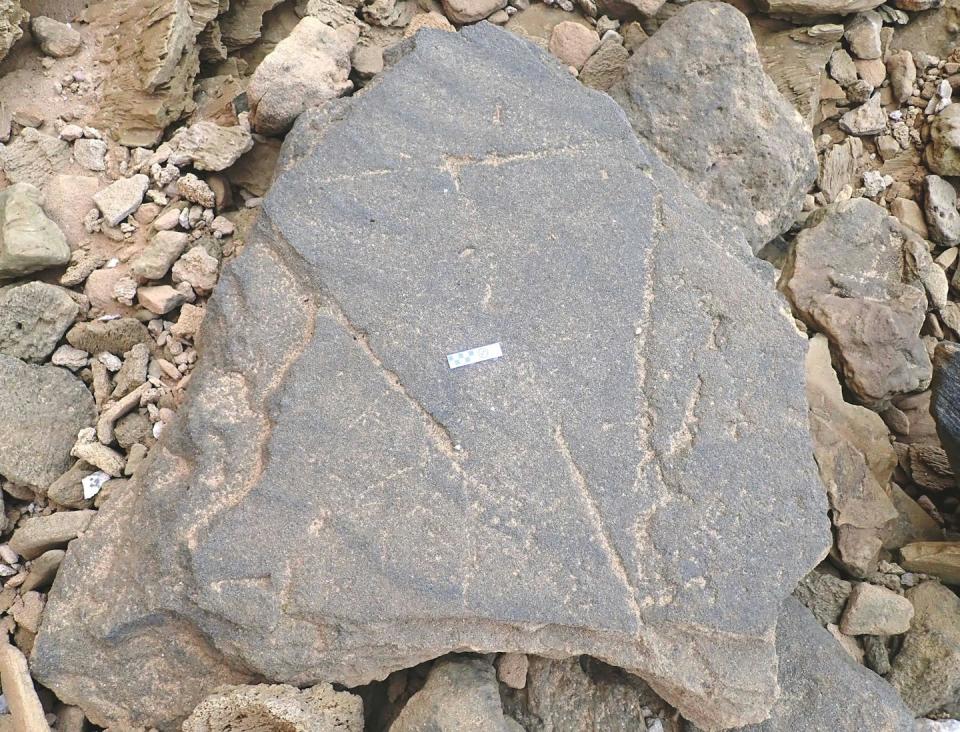Scientific breakthroughs can happen in the strangest ways and in the strangest places. Alexander Fleming discovered penicillin because of mold that grew in a petri dish left out while he was on vacation. Chinese monks in the 9th century wanted to make a potion for immortality: instead, they discovered gunpowder.
Our remarkable discovery happened on a rugged, remote stretch of coast east of Still Bay on the southern Cape coast of South Africa. The tide was low and three members of our ichnology team (people who study tracks and tracks) were in search of newly exposed remains Pleistocene vertebrate tracks in eolianites (cemented dunes).
Ahead we saw a large boulder that had fallen from the cliffs above. On its surface was a pattern of linear grooves in a large triangular shape, complete with a nearly perfect groove. The sides of the triangle were almost a meter long. After extensive research, we concluded that these grooves must have been made in an unconsolidated sand dune surface by our human ancestors in Middle Stone Age. The patterns are probably between 143,000 and 91,000 years.
It was an important discovery in a significant place. Multiple lines of evidence on this coast indicate which is an area where our distant ancestors became truly modernusing fire as an engineering tool and creating abstract images.
See more information: What triangular patterns in rocks can reveal about human ancestors
But there was a problem. On a follow-up visit, we found a smaller rock nearby with a similar triangular feature. It was later destroyed, probably by storms or high tides that hit and toppled it. We knew that the larger rock would inevitably suffer a similar fate if we did nothing. From our point of view, this is one of the most important rocks in the world: it takes us back to our roots as a species and indicates the kind of “proto-art” we were able to create so long ago.
So we organized an unusual mission: a “rescue” operation designed to take the approximately 500-kilogram rock to safety – in a museum.
A coordinated mission
Given the size and weight of the rock, there was only one way to remove it: with a helicopter, a skilled pilot, and a strong net attached to a longline cable.
Our research team has accumulated funding through contributions paid to a book project. This money went towards hiring a private helicopter and pilot, as well as hiring a ground crew on the day. We also obtained approval from the owner of the private land where the rock was located. We also needed authorization from the provincial heritage authority to proceed because the rock is a precious heritage item.

It was a desperate process. The rock may have broken when lifted from the cliff or may have fallen into the sea. But September 29, 2022 – what we call Recovery Day – went well. The ground crew and helicopter pilot cooperated superbly. Minutes after being removed from the remote location, the rock was safely on a pallet in a truck at the local airfield. From there, a very cautious journey began to the Blombos Archeology Museum in nearby Still Bay. Here it was lifted and gently lowered into place by a dozen volunteers.
The rock was later encapsulated and exposed, with interpretive text panels. Joins similar exhibitions at the museum; the grooves were an example of amoglypha term we created to describe a human-created pattern in sand that is now evident in rock that has been cemented and then re-exposed.
Attributing meaning to these geometric patterns made so long ago by our distant ancestors is not within our field of expertise. Still, we couldn’t help but notice the similarity of the triangular shape to a supposed symbol of fertility found in France and dated to around 38,000 years old. If our rock pattern represented the same motif, it wouldn’t be the first time that Southern African discoveries had pushed back in time which was seen as an Upper Paleolithic Eurasian phenomenon.
Our research team now sleeps better at night, knowing that this priceless piece of our human heritage has been recovered and is available for others to see, appreciate and critique.
More to discover
Fortunately, there was an unexpected bonus. Next to the eroded remains of the second rock, our ground team noticed a third rock surface that had not previously been evident. Near one edge it contained a distinct pair of grooves that met at a 69-degree angle, forming what may have been part of another triangular feature.
This is clearly an area we will return to again and again, in the hope that tidal forces might turn over other rocks before destroying them, and might give us the opportunity to glimpse – and perhaps recover – more ammoglyphs.
This article was republished from The conversation, an independent, nonprofit news organization that brings you trusted facts and analysis to help you understand our complex world. It was written by: Carlos Helm, Nelson Mandela University It is Jan Carlo De Vynck, Nelson Mandela University
See more information:
The authors do not work for, consult with, own shares in, or receive funding from any company or organization that would benefit from this article, and have disclosed no relevant affiliations beyond their academic appointment.
































/cdn.vox-cdn.com/uploads/chorus_asset/file/24007892/acastro_STK112_android_01.jpg?w=150&resize=150,150&ssl=1)